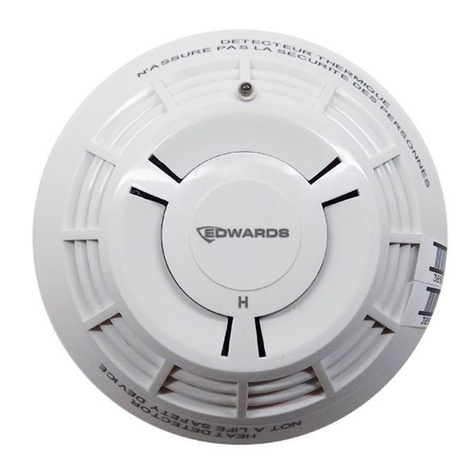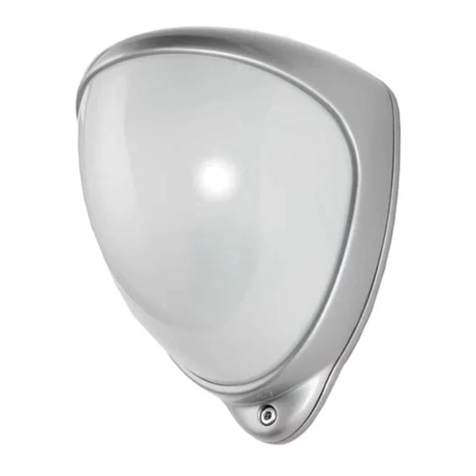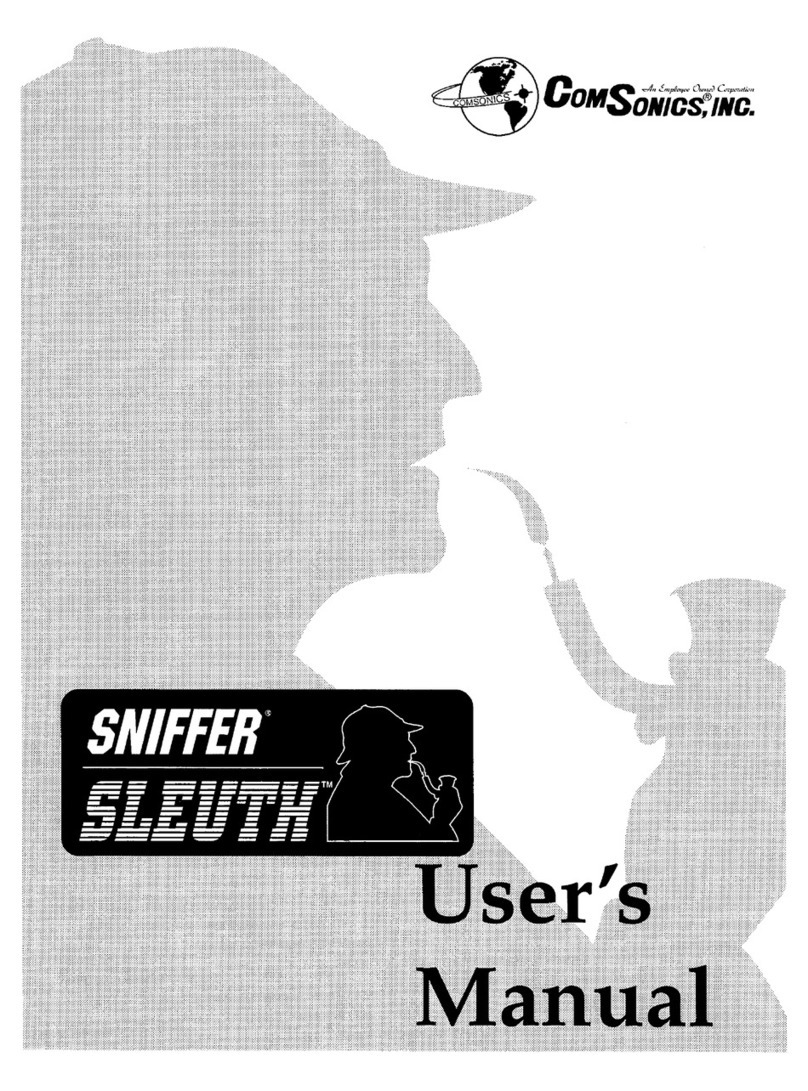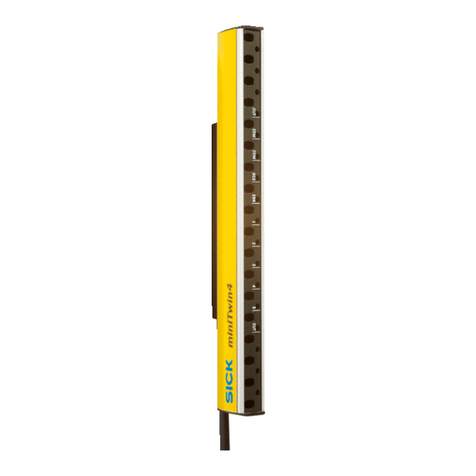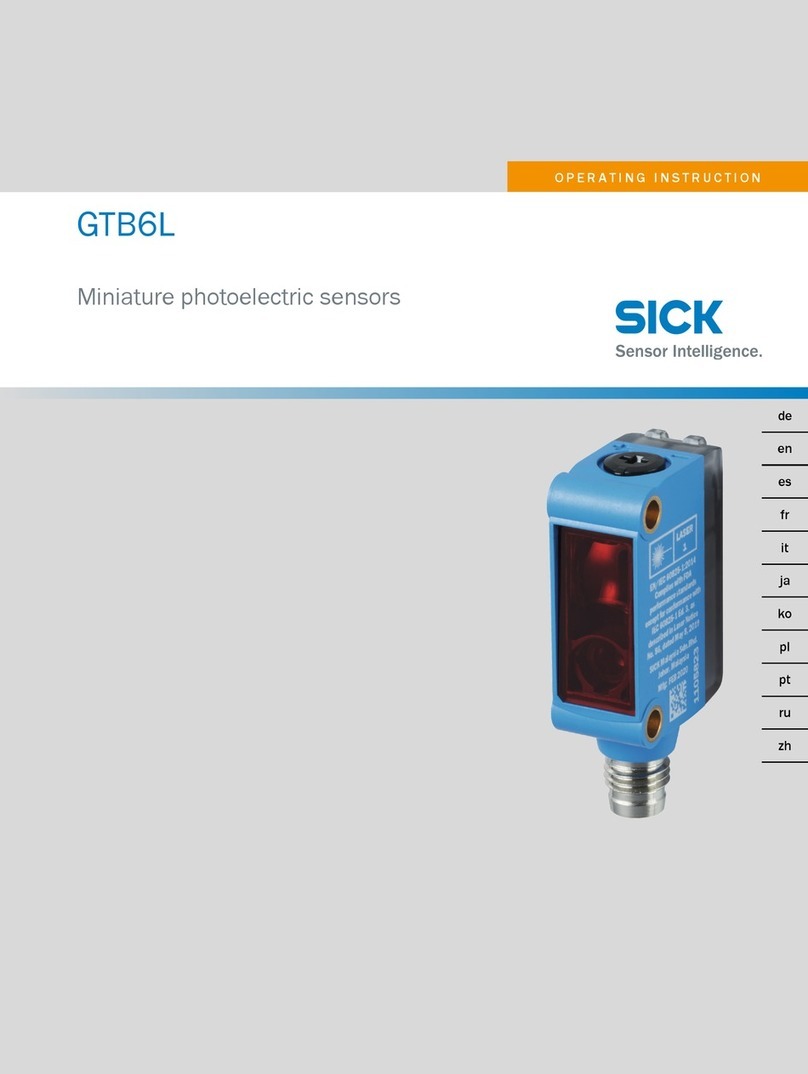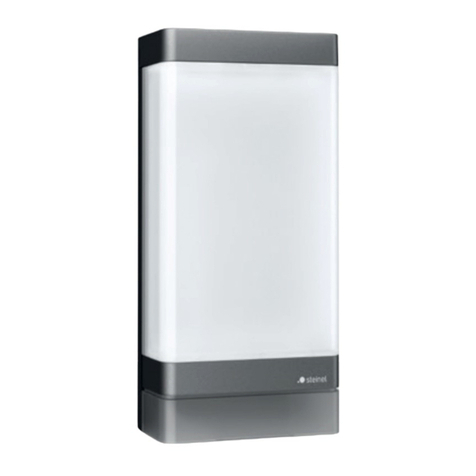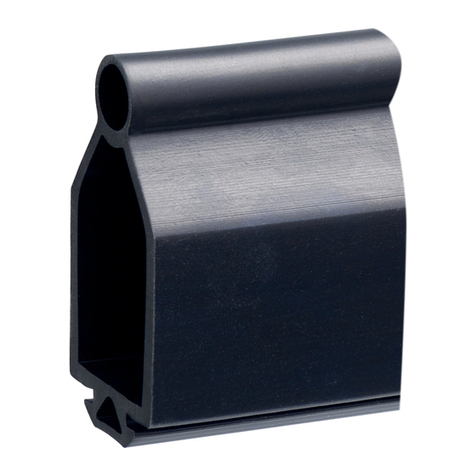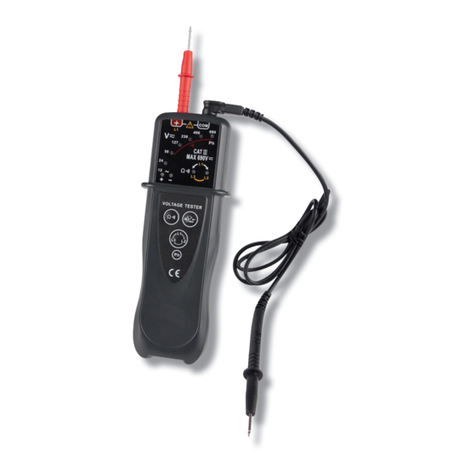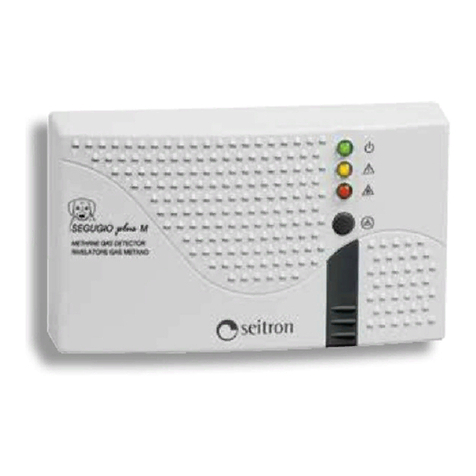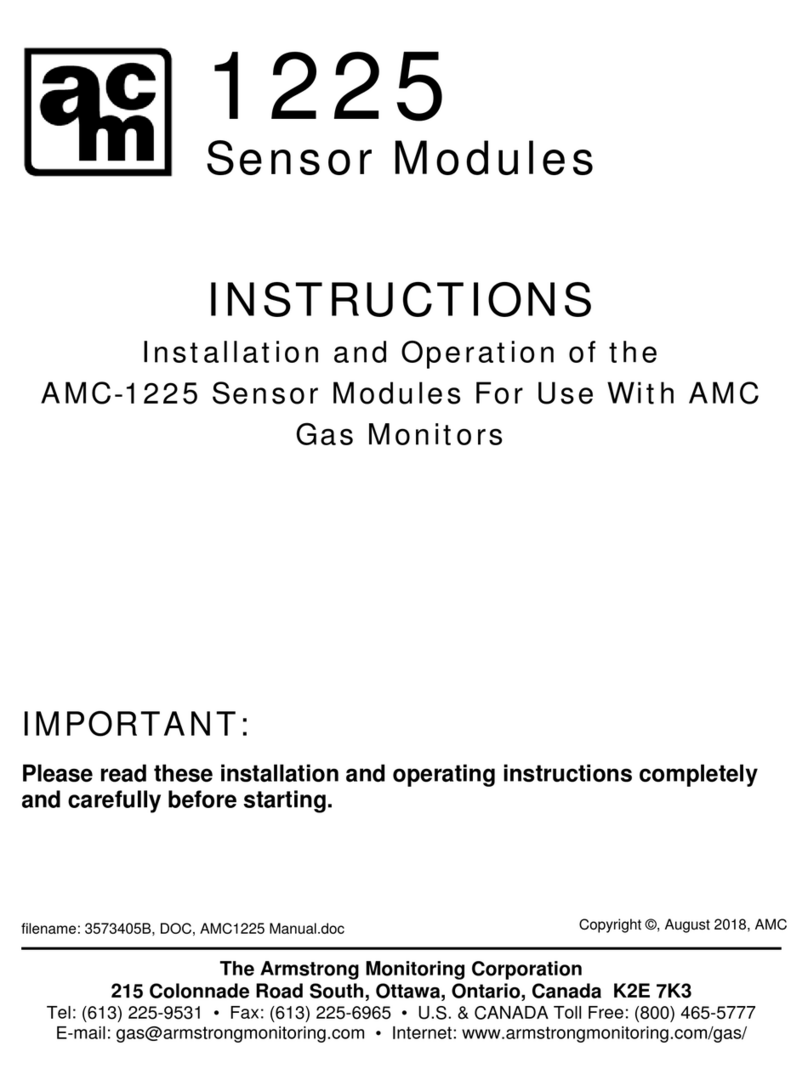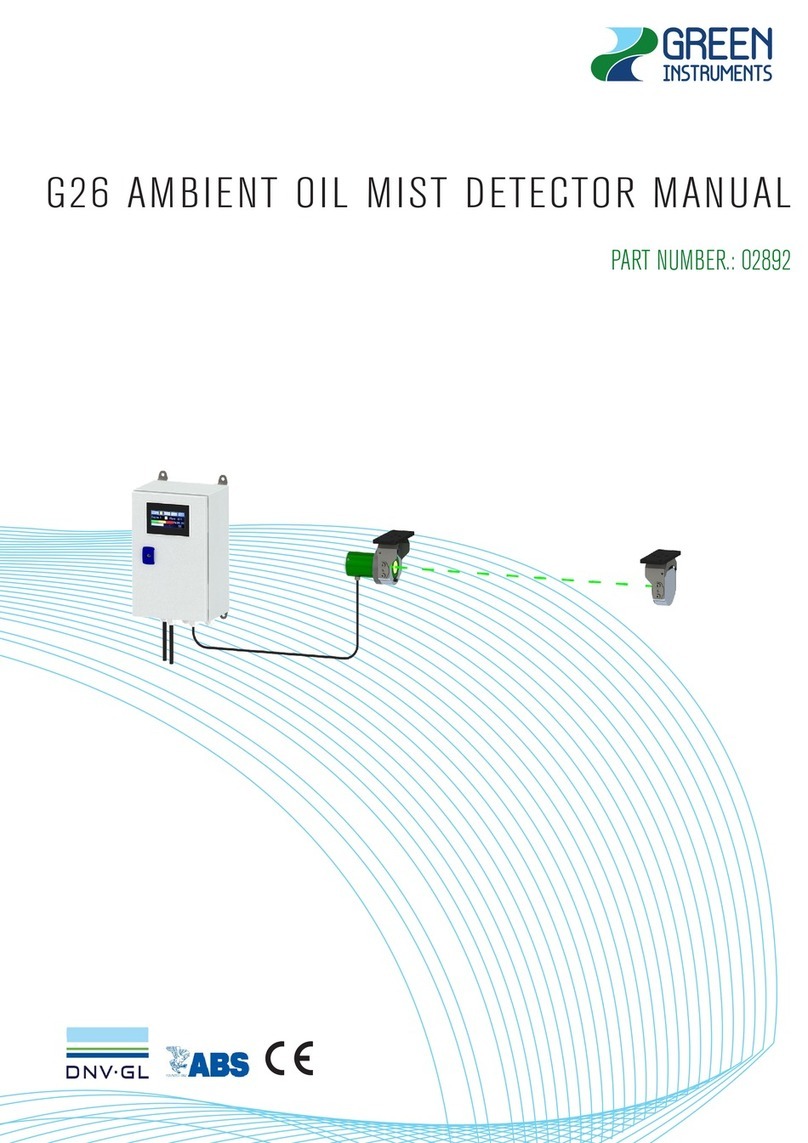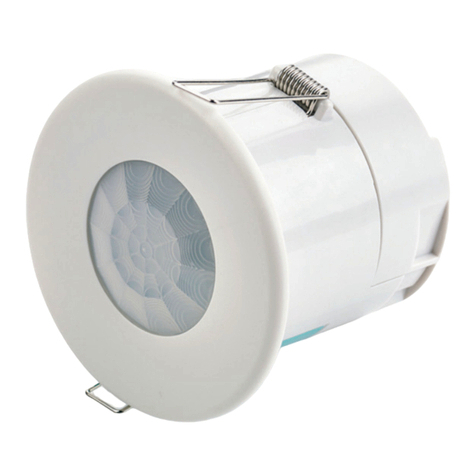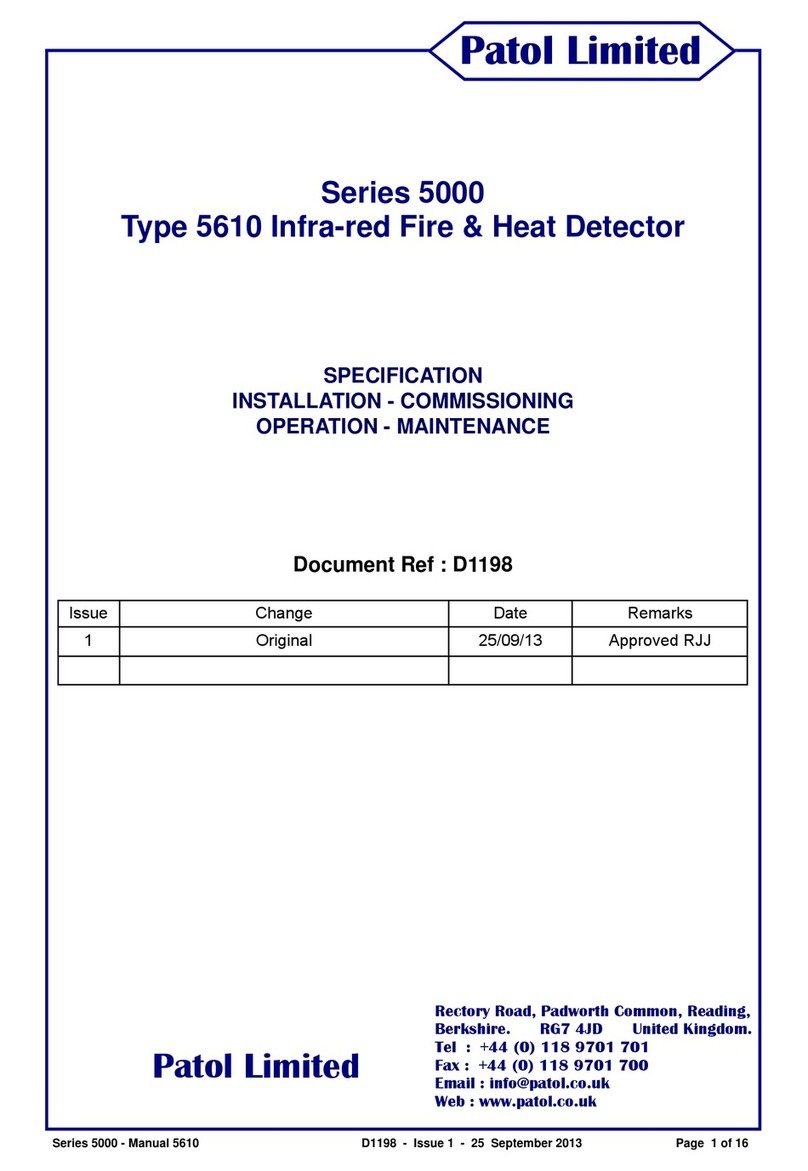SST F120 Guide

23282 Mill Creek Drive, Suite 215
Laguna Hills, CA 92653 USA
+1.949.583.1857 Phone
+1.949.340.3343 Fax
www.safetysys.com
Triple-Mode UV/IR
Flame Detector
70053
Model F120
Design Manual
Installation • Operation • Maintenance
The information and technical data disclosed by this document may be used and disseminated only for the
purposes and to the extent specifically authorized by Safety Systems Technology in writing. Such information and
technical data are proprietary to Safety Systems Technology and may not be used or disseminated except as
provided in the foregoing sentence.

Blank Page

January, 2016 i
Quick Finder
MODEL F120 UV/IR
Triple-Mode Flame Detector
SAFETY INFORMATION................................................................................... 120-3
QUICK INSTALLATION GUIDE......................................................................... 120-4
TOOLS REQUIRED ......................................................................................................120-4
QUICK INSTALL GUIDE ...............................................................................................120-4
GENERAL DESCRIPTION................................................................................ 120-8
TRIPLE MODE UV/IR ..................................................................................................120-8
USER CUSTOMIZABLE MODES .................................................................................120-9
PHYSICAL DESCRIPTION ..........................................................................................120-9
OPERATIONAL DESCRIPTION....................................................................................120-9
SPECIFICATIONS ........................................................................................... 120-11
SYSTEM SPECIFICATIONS.......................................................................................120-11
ELECTRICAL SPECIFICATIONS................................................................................ 120-11
ENVIRONMENTAL SPECIFICATIONS .......................................................................120-12
MECHANICAL SPECIFICATIONS ..............................................................................120-12
SELECTING A LOCATION FOR THE FLAME DETECTOR............................ 120-13
CONSIDERATIONS ....................................................................................................120-13
OPTICAL SENSITIVITY RANGE ................................................................................120-13
FIELD OF VIEW .........................................................................................................120-13
ORIENTATION OF THE FLAME DETECTOR ............................................................120-18
DUST, DEBRIS, SALT, AND SNOW............................................................................120-18
ENCLOSURES PROTECTED BY GLASS, AND PLEXIGLAS ...................................120-18
REQUIRED QUANTITY OF FLAME DETECTORS ...................................................120-19
AVOIDING SOURCES OF FALSE ALARMS...............................................................120-19
ELECTRICAL WIRING .................................................................................... 120-21
TERMINAL CONNECTIONS.......................................................................................120-21
POWER.......................................................................................................................120-22
WIRING CONSIDERATIONS......................................................................................120-22
MAXIMUM CABLE LENGTHS ....................................................................................120-22
DEFAULT CONFIGURATION.......................................................................... 120-23
INSTALLATION................................................................................................ 120-24
1. SHIPMENT ............................................................................................................120-24
2. TOOLS REQUIRED ..............................................................................................120-24
3. DISASSEMBLE THE DETECTOR ........................................................................120-24
4-A. INSTALL THE CONDUIT SWIVEL MOUNTING BRACKET ...............................120-25
4-B. INSTALL THE WALL/CEILING MOUNTING BRACKET.....................................120-26
5. WIRE THE DETECTOR .........................................................................................120-27
TERMINAL CONNECTIONS.......................................................................................120-28
ALARM CONTACT RELAYS CONNECTION..............................................................120-31
DELAYED ALARM CONTACT RELAYS CONNECTION.............................................120-31
FAULT CONTACT RELAYS CONNECTION ...............................................................120-31
6. CONNECT THE DETECTOR TO EARTH GROUND..............................................120-32
7. SET THE DETECTION MODE DIP SWITCH.........................................................120-32
8. SET THE TIME DELAY FOR THE DELAYED ALARM OUTPUT ...........................120-34
9. SET THE LATCHING MODE FOR THE DELAYED ALARM .................................120-34
10. INSTALL THE ELECTRONICS MODULE ............................................................120-35
11. INSTALL THE FRONT HOUSING ........................................................................120-36
12. APPLY POWER....................................................................................................120-37
13. PERFORM FINAL OPERATIONAL CHECKOUT .................................................120-38

ii January, 2016
14. INSTALL ACCESSORIES ....................................................................................120-39
ROUTINE OPERATION ................................................................................. 120-40
LED INDICATOR ........................................................................................................120-40
NORMAL OPERATION ..............................................................................................120-40
ALARM AND DELAYED ALARM MODE ....................................................................120-40
SYSTEM FAULT .........................................................................................................120-41
MAINTENANCE ............................................................................................. 120-42
FACTORY RECOMMENDED MAINTENANCE ..........................................................120-42
MONTHLY OPERATION TEST ...................................................................................120-42
QUARTERLY LENS CLEANING ................................................................................120-43
FRONT AND REAR THREAD LUBRICATION ............................................................120-43
O-RING LUBRICATION...............................................................................................120-43
ANNUAL VERIFICATION ............................................................................................120-43
MONTHLY OPERATING TEST INSTRUCTIONS ........................................... 120-44
FACTORY RECOMMENDED TEST SCHEDULE.......................................................120-44
WHEN TO TEST THE FLAME DETECTOR................................................................120-44
TOOLS REQUIRED ...................................................................................................120-45
STEP-BY-STEP TEST PROCEDURE.........................................................................120-45
FAILED OR INCOMPLETE TEST ...............................................................................120-46
CHANGING THE DETECTION MODE ........................................................... 120-47
DETECTION MODES ...............................................................................................120-47
TOOLS REQUIRED ...................................................................................................120-47
STEPS TO CHANGE THE DETECTION MODE.........................................................120-48
REPLACING THE ELECTRONIC MODULE ................................................... 120-51
ORDERING INFORMATION .......................................................................................120-51
TOOLS REQUIRED TO REPLACE THE ELECTRONIC MODULE............................120-51
STEPS TO REPLACE THE ELECTRONIC MODULE ...............................................120-51
REPLACING THE SELF-TEST LAMP............................................................. 120-56
ORDERING INFORMATION .......................................................................................120-57
TOOLS REQUIRED TO REPLACE THE ELECTRONIC MODULE............................120-57
STEPS TO REPLACE THE SELF-TEST LAMP ELECTRONIC MODULE ................120-57
REPLACING THE SENSOR ........................................................................... 120-59
HOW TO REPLACE THE SENSORS .........................................................................120-59
TROUBLESHOOTING .................................................................................... 120-60
AUTOMATIC SELF-CHECK .......................................................................................120-60
LED INDICATOR .........................................................................................................120-60
FAULT YELLOW LED INDICATOR IS ON ..................................................................120-60
FALSE ALARMS..........................................................................................................120-62
TRANSIENT INTERFERENCE OR POWER SURGES..............................................120-63
TECHNICAL SUPPORT .............................................................................................120-64
SPARE PARTS AND ACCESSORIES............................................................. 120-65
REPLACEMENT ELECTRONICS MODULE ..............................................................120-65
REPLACEMENT HOUSING .......................................................................................120-65
TEST EQUIPMENT.....................................................................................................120-65
ACCESSORIES ..........................................................................................................120-65
WARRANTY .................................................................................................... 120-66
REPAIRS ......................................................................................................... 120-67
ENCLOSURE DRAWING ................................................................................ 120-68
WIRING DIAGRAM ......................................................................................... 120-69
NAMEPLATE DRAWING................................................................................. 120-70
SWIVEL BRACKET DRAWING....................................................................... 120-71
APPROVALS ................................................................................................... 120-72

January, 2016 120-1
Model F120 UV/IR Flame Detector
MODEL F120 UV/IR
Triple-Mode Flame Detector
SAFETY INFORMATION
Please read and understand this Design Manual BEFORE installing, operating, or conducting
maintenance on the ame detector.
Pay close attention to important messages marked as WARNINGS and IMPORTANT
throughout the Design Manual.
Failure to follow the instructions and safety precautions in this Design Manual can result in
serious injury or death.
Equipment that has been repaired or modied by the user, damaged as a result of an accident,
improper installation or used in an environment for which it was not intended will void the
warranty.
INSTALLATION WARNINGS
Installation of the detector must only be conducted by trained and in some cases a licensed
personnel.
Observe the recognized standards of the appropriate authority in the in the country concerned.
Follow all appropriate standards to maintain the overall certication of the detector. Ensure
all local regulations and site safety procedures are followed.
Declassify the area or disconnect the equipment from the power supply before accessing the
interior of the detector. Ensure that the cover for the housing is closed tight during operation.
DO NOT open the housing/enclosure or replace the electronic module in potentially hazardous
atmospheres while the POWER is still applied to the electronics module.
DO NOT tamper, modify, repair, or disassemble the electronics module or the detector.
DO NOT expose the detector to temperatures outside the recommended ranges or damage
or failure may occur.
Every effort has been made to ensure the accuracy of this Design Manual. However, Safety
Systems Technology assumes no responsibility for any errors or omissions in this document.
Please report any errors or omissions found in the content of the Design Manual.
Safety Systems Technology reserve the right to change or revise this Design Manual without
notice and without obligation to notify any person or organization of such changes. You may
request any additional information required that is not included in the Design Manual through
the local distributor or Safety Systems Technology.

120-2 January, 2016
Model F120 UV/IR Flame Detector
QUICK INSTALLATION GUIDE
Tools Required
4 mm hex wrench is required.
Flat head screwdriver 3/16 inch (5 mm) width for terminal block connections.
Adjustable wrench for conduit or cable gland connections.
!WARNING: De-classify the area to reduce the risk of ignition of hazardous atmosphere.
Combustible and ammable gases and vapors are very dangerous. Extreme caution
should be taken when these hazards are present.
Quick Install Guide
1. Disassemble the ame detector. Use a 4 mm hex wrench to loosen the locking screw
on rear of the detector.
2. Remove the electronics module from the rear housing.
3. Install the mounting brackets.
If using conduit, install the Conduit Mounting Bracket. A conduit seal tting must be
used within 18 inches (46 cm) from the ame detector.
If usng a Wall/Ceiling Mounting Bracket, use a suitable cable gland with 3/4 inch NPT
male thread

January, 2016 120-3
Model F120 UV/IR Flame Detector
Wall or Ceiling Mounting Bracket Conduit Mounting Bracket
Conduit Mounting Assembly
4. Run the wires through the rear housing conduit opening of the ame detector
5. Wire and connect the detector to earth ground (see Wiring Diagrams on next pages)
6. Plug the electronics module
Note that the terminal blocks of the electronics module and rear housing each have
protective (RED) polarizing keys. Orient so that the Red Keys on the electronics are
NOT aligned with the Red Keys on the terminal blocks.
7. Screw the front housing to the rear
housing, hand tight only
8. Align the “aligning marks” on the front
and rear housing.
9. Apply power
10. Perform Final Operational Checkout per
Design Manual
11. Install accessories, if any

120-4 January, 2016
Model F120 UV/IR Flame Detector
Wiring Diagram

January, 2016 120-5
Model F120 UV/IR Flame Detector

120-6 January, 2016
Model F120 UV/IR Flame Detector
GENERAL DESCRIPTION
A re is composed of heat and light, both visible and
invisible. And during the combustion process, smoke
may be generated. A re will emit specic radiation in the
infrared and ultraviolet spectrum. A ame detector uses
specialized sensors to detect these radiations to report
and conrm a re.
The protection of onshore and offshore hydrocarbon
process and handling facilities against any loss from
res requires positive and fast-responding optical ame
detectors, with no tolerance for false alarms or nuisance
alarms caused by either EMI, lighting, x-rays, gamma
radiation, arc welding, reected sunlight, or any light source
such as mercury or quartz iodine ood lights. Traditional
UV and UV/IR detectors can be blinded by precombustion
smoke, thus rendering the detector useless under these
conditions. Also, oil mist or oil deposits on the quartz
lens of a UV detector or single mode UV/IR detector will
seriously diminish the response to a re. Therefore, we
do not recommend using these types of detectors in a
hydrocarbon environment.
Triple Mode UV/IR
Safety Systems Technology’s Model F120 “Triple-Mode” UV/IR Optical Flame Detector uses
the latest state-of-the-art microprocessor and circuity, eliminating the shortcomings of currently
available UV/IR detectors which are subject to the aforementioned interferences.
The F120 ame detector monitors for specic radiation emitted by a re through the use of 3
sensors - one UV (ultraviolet) sensor and two IR (infrared) sensors. The UV sensor provides
the shortest response time in detecting radiation from a re. However, in some cases, dense
precombustion smoke may blind the UV sensor. In other cases, false alarm sources such
as arc welding and lightning emits UV radiation which can trigger a UV sensor. The Model
F120 requires two of its three sensors to signal an alarm. Should the UV sensor be blinded
by dense smoke, the two IR sensors will still detect the infrared radiation emitted by a re.
Likewise, the use of three sensors to conrm a re allows the detector to reduce false alarms
from other sources of radiation.
Outputs are either voted automatically, or can be manually selected by the end-user. Selected
outputs can either be for UV only, IR icker only, IR icker and Temperature, or any two out of
three combination. The ame detector’s “Triple-Mode” operating principle or “voting” capability
is what sets this detector apart from any other UV/IR detector. This detector will see a re,
while other manufacturer’s detectors may not. To insure reliable operation, the detector is
equipped with an automatic Optical Self-Checking feature which continuously checks the
optical viewing window for cleanliness and conrms operation of the detector circuits.

January, 2016 120-7
Model F120 UV/IR Flame Detector
User Customizable Modes
The Model F120 is a highly versatile ame detector that provides multiple modes of operation:
Triple Mode UV/IR
This mode utilizes three sensors to detect a re, one solar-blind UV sensor and two IR sensors.
The detector takes advantage of the use of these three sensors to conrm a re and reduce
false alarms and it will not be blinded by dense smoke which makes this detector superior
to other brands in the market today. It is suitable for both indoor and outdoor use and offers
increased false-alarm immunity over a UV detector.
UV Mode
This mode utilizes the solar-blind UV sensor only. It is ideal for use indoors and in areas not
susceptible to sources of false alarms. This mode provides the shortest response rate as it
will detect UV radiation instantaneously.
Dual IR Mode
This mode utilizes the two IR sensors within the detector. The two IR sensors specically
detect the IR icker of a ame and the spike in Temperature in the Hydrocarbon CO2 band.
This combination provides a ame detector which is highly immune to false alarms.
IR Mode
This mode utilizes an IR sensor to monitor for the icker generated by a ame. It permits the
detector to ignore steady state IR sources such as hot objects.
Physical Description
The Model F120 is self-contained in a two-piece explosion-proof copper-free aluminum housing
nished in a deep red color for rapid identication as a ame detector. A protective coating
permits use in harsh environments, such as offshore platforms, without degradation. The
detector is suitable for use in “classied” areas where ignitable concentrations of ammable
gas normally exist. A sapphire window in the front of the housing permits both ultraviolet
and infrared radiation to strike the sensing elements inside. Electrical connections are made
through a 3/4 inch threaded outlet on the rear of the detector, suitable for connection to
electrical conduit or a cable gland.
Operational Description
Contained within the Model F120 Flame Detector housing are the UV, IR and heat sensing
elements and associated electronics, three (3) contact relays, and screw terminal blocks for
wiring. The detector may be installed for completely self-contained operation, utilizing the
relays to control local equipment directly. Additionally, the alarm and status conditions may
be transmitted by the detector to a central control room. The relay contacts, if not being
used for local control, may be hard-wired to the control room to transmit these conditions. Or
all conditions may be transmitted over a single wire by using the available 0-20 mA signal.
When the detector is installed and operating normally, the green LED indicator light will be
visible through the detector window. This provides a rapid visual check of detector operation
and indicates the unit is in operation. The Model F120 Flame Detector responds to a ame
with a variety of criteria and time delay settings. A multiposition selector switch sets the
detector for the most appropriate mode for the exact conditions at your particular installation.

120-8 January, 2016
Model F120 UV/IR Flame Detector
Alarm and Delayed Alarm
The Model F120’s standard conguration requires at least two of its three sensors to be
activated to signal an alarm. When ame radiation is initially detected, the Alarm outputs,
both relay contact and current loop, are instantly activated. A red LED alarm light behind the
viewing window in the detector is also activated. The detector has a default Delayed Alarm
setting of six seconds to conrm a ame has been detected. Should this ame persist for
this period of time, the Delayed Alarm output (relay and current loop) will be activated. The
Delayed Alarm setting can also be changed from six seconds to three seconds to provide a
rapid response time.
Automatic Self-Check (ASC)
Periodically, the Model F120 Flame Detector runs the Automatic Self-Check program. A
source of UV radiation is transmitted, via a sapphire rod to the outside surface of the viewing
window, and then passes through the window onto the sensor element. This test ensures
that the sapphire window is clear of any obstruction and that the sensors inside the detector
are functioning properly. Should the transmission of the window be degraded, or other circuit
malfunctions detected, the yellow Malfunction LED in the detector will turn on, the malfunction
relay contacts will transfer, and the 0-20 mA output will transmit a malfunction signal. This
malfunction indicates a need for maintenance before the performance has been degraded
enough to prevent response to ame.
.

January, 2016 120-9
Model F120 UV/IR Flame Detector
SPECIFICATIONS
System Specications
Spectral Response ................ UV: 185 to 245 nm
IR: 4.3 microns (Hydrocarbon CO2spike)
Detection Range ................... Reliably detects a one square foot n-Heptane re at a
distance of 70 feet / 20 meters
Response Time ..................... < 5 seconds
Adjustable Time Delay .......... 3 or 6 seconds
Detection Modes ...................
Triple-mode
: UV, IR icker, and Temperature (voted any two
out of three sensors)
UV Mode
: UV
Dual IR Mode
: IR icker and Temperature (Hydrocarbon
CO2spike)
IR Mode
: IR icker
Optical Self-Test: ................... Automatic continuous optical path
Warranty: ............................... 5 years
Approvals .............................. Classied by Underwriters Laboratories for use in Class I,
Groups B, C, D; Class II, Groups E, F, and G Hazardous
Locations. FTRV, File No. E162517(N)
Classied by Underwriters Laboratories for use in Class I,
Groups B, C, and D; Class II Groups E, F, and G Hazardous
Locations per Canadian Standard C22.2 No. 30-M1986 and
25-1966. File No. E162517 (N).
The enclosure is rated NEMA Type 4X, watertight and
corrosion resistant.
Electrical Specications
Input Power ........................... 20-35 VDC, 125 mA standby, 230 mA alarm @ 24 VDC
Relay Contact Ratings .......... 6 amps @ 28 VDC or 300 VAC resistive
1/8 HP @ 120-240VAC
Analog Signal ........................ Self-powered output transmits a 0-20 mA current load of 100
to 800 ohms to indicate operating mode of detector. Delayed
Alarm selectable for latching or non-latching operation.
Power Fault 0 mA
Malfunction 2 mA
Ready 4 mA
UV Alarm (special order) 8 mA
Alarm 12 ± 1 mA
Delayed Alarm 19 ± 1 mA
Relay Outputs ....................... Alarm (instantaneous, non-latching);
Delayed Alarm (3 or 6 seconds, latching or non-latching);
Malfunction
Alarm Reset .......................... Automatic or manual when ame is no longer detected
Visual Indicators .................... Detector Ready - Green LED
Alarm/Delayed Alarm - Red LED
Malfunction - Yellow LED
Field Connections ................. 0-20 mA output - three-wire shielded cable
All other connections: 18 AWG (3.5 mm2) to 14 AWG (2.5
mm2)

120-10 January, 2016
Model F120 UV/IR Flame Detector
Environmental Specications
Operating Temperature ......... -40°F to 185°F (-40°C to 85°C)
Operating Humidity ............... 0-100% RH, non-condensing
Ingress Protection ................. IP66
Mechanical Specications
Dimensions ........................... 4.40 x 5.25 inches (112 x 133 mm)
Weight ................................... 4.0 lbs (1.8 kg) Aluminum
10.0 lbs (4.5 kg) Stainless Steel
Housing ................................. Aluminum or Stainless Steel
(1) Front Housing
(2) Viton O-Ring Seal
(3) Self-test UV Emitter
(4) Plug-in Electronics Module
(5) Terminal Blocks
(6) Rear Housing

January, 2016 120-11
Model F120 UV/IR Flame Detector
SELECTING A LOCATION FOR THE FLAME DETECTOR
!NOTE: The determination of the location of ame detectors should be made in
accordance with any relevant local, municipal, and national standards, codes, or
legislation. Seek the advice of professionals or experts with knowledge of process
plant systems and/or safety and engineering personnel.
Considerations
To insure the fastest possible detection of ames, the location of the detector is important.
There are no standard rules for detector placement since the optimal placement of the
detector(s) are different for each application. The following considerations should be made
when locating ame detectors:
• The ame detector must have an unobstructed view of the area it is intended to protect.
• Detectors should be installed in an area as free of shock and vibration as possible
• Although the detector has been designed to recognize sources of false alarms and
prevent it from being activated, it is virtually difcult to eliminate all the varying factors that
may trigger a false alarm. Determine an optimum location to place the detector to reduce
or eliminate these sources of false alarms.
• A clear view of the detector for visual inspection and convenient access for cleaning
• In areas with dirty atmospheric conditions, the detectors will require frequent inspection
and cleaning
• In high trafc areas, the detector should be placed a minimum of 10 feet from the
protected area to ensure ample coverage and to prevent obstructing the eld of view of
the detector by personnel working or machines passing by
• For outdoor installations exposed to intense, direct sunlight, utilize a sunshade to protect
the detector from extreme temperatures
• Do not begin installation unless all considerations regarding the location of the detector
have been taken into account.
Optical Sensitivity Range
The distance at which the ame detector will respond to a re is a function of the intensity of
that re. The F120 has a maximum detection range of 70 feet (21 m) for an n-Heptane re
with a surface area of 1 sq ft (0.093m2).
Field of View
Flame detectors exhibit reduced sensitivity to ames that are not directly in front of them (on
axis). Relative sensitivity at various off axis angles is described in the eld of view diagram.
It denes the detector sensitivity as a function of ame location in the eld of view. For
example, if the ame is located directly in front of the detector, an angle of zero degrees (0°)
the detector will respond to the standard 1 square foot n-Heptane re at a distance of 70
feet (21 meters). At 30° off axis, the sensor sensitivity is approximately 85% of the on-axis
sensitivity; resulting in a reduction of the effective range of the detector to about 55 feet (17
meters). Note that the worst case detection range for the detector will be a range of 35 feet
at 45° off-axis.
Utilize the eld of view diagram and a drawing of the area to be protected in specifying the
mounting elevation and detector orientation. Where required, additional F120 units should
be utilized to insure adequate coverage.

120-12 January, 2016
Model F120 UV/IR Flame Detector

January, 2016 120-13
Model F120 UV/IR Flame Detector

120-14 January, 2016
Model F120 UV/IR Flame Detector

January, 2016 120-15
Model F120 UV/IR Flame Detector

120-16 January, 2016
Model F120 UV/IR Flame Detector
Ceiling
Wall
Orientation of the Flame Detector
The F120 will operate in any orientation. Recommended orientation is above the intended
protective zone to insure a clear eld of view and minimal accumulation of dust and debris on
the lens surface. The detector can be mounted at a minimum declination of 20 degrees or at
the recommended declination of 45 degrees. If the ame detector is installed at a corner of
a room at a 45 degree angle, the coverage path of the detector will extend from the detector
across the ceiling and from the detector straight down the wall and towards the oor. The
F120 detector housing is marked “TOP” to identify the recommended side of the detector
that should be mounted facing up. This orientation prevents the accumulation of dust and/
or debris on the lens and the self-test oriface.
Dust, Debris, Salt, and Snow
If the detector is installed above the intended protective zone, angle the detector a minimum
of 20 degrees down or at the recommended declination of 45 degrees to prevent any
accumulation of dust, debris, salt or snow on the lens.
The internal electronics of the detector generates enough heat that no icing should occur.
Utilize a shade or cover if necessary to protect the lens from heavy snow.
Enclosures Protected by Glass, and Plexiglas
The ame detector must have an unobstructed view of the area it is intended to monitor.
If an area is enclosed with a glass or Plexiglas, UV and IR radiation will not travel through
these materials and will not be detected by the detector. Please consult with Safety Systems
Technology for recommendations regarding your specic application.
Table of contents
